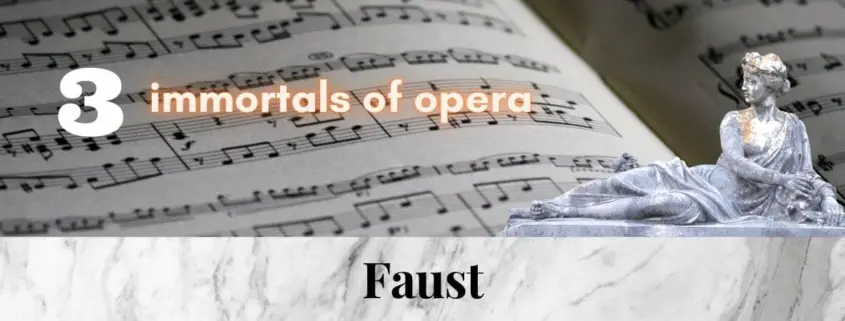3 immortal pieces from Gounod’s FAUST – the best interpretations in YouTube
Gounod’s Faust is one of the very great operas. It is a masterpiece with many pieces that have become famous. The role of Margarethe is one of the most beautiful and demanding parts in opera literature.
Faust great aria ” Salut! demeure chaste et pure”
A feature of this famous aria is that the tenor is accompanied by a solo violin, which plays around his voice throughout the piece. Berlioz felt that this artifice of Gounod’s “does much more harm than good to the whole, and I think the singer Duprez was right, who one day, when an instrumental solo in the orchestra accompanied him in a romance, said, “This devil’s instrument, with its runs and variations, irritates me like a fly buzzing around my head and wanting to sit on my nose. ”
Conde countered that Gounod was using the violin to say what the words could only half say (“ ce que les mots ne disent qu’à demi “).
Fausts’ words are spiritual and expressive. Words like ” innocente et divine ” or ” Que de richesse ” give the singer the opportunity to show the subtlety and richness of his voice. The intensity steadily increases until the climactic climax of the aria with the spectacular high C, which should be sung tastefully and in no case be made coarse and applauding, which would destroy the mood of this piece. The piece ends beautifully with the solo violin in the Adagio.
Björling’s interpretation is perhaps unbeatable. He has recorded this aria repeatedly. In this recording we see him in a television production. We note an uncertain look at the beginning, but then Björling beguiles the listener from the first second. He transforms into a tender, romantic lover. His singing and playing is of great naturalness, as is the high C of the ending. This performance, along with Caruso’s interpretation, is and was the blueprint for all the tenors that followed them.
Salut, demeure chaste et pure – Björling
[/av_image]
Margarete sees the jewels – the famous jewel aria
This piece requires the vocal range of a lyric coloratura soprano. Most of the opera is written for a lirico-spinto, dramatic soprano who can credibly portray the full range of emotions: She must portray the innocence of the young woman, then be Faust’s lover, then the devout churchgoer, later the tragically abandoned, and finally the mad, incarcerated one. In this aria, the music of the coquettish young woman, peppered with ornamentation, is now added.
This wide range of demands makes Margarete one of the most demanding roles in operatic literature and, accordingly, difficult to cast. The famous British singer critic John Stean wrote in 1971 that in the history documented by records only four singers could cover this entire vocal spectrum: Lili Lehmann, Rosa Ponselle, Maria Callas and Montserrat Caballé. There are recordings of this opera by two of these singers.
With great, playful playfulness and beautiful voice, we hear Angela Gheorghiu.
Ah! je ris de me voir – Gheorghiu
The grandiose tercet of the dungeon scene
This tercet is one of the most beautiful passages in the opera. If one takes comparable scenes from other works as a yardstick (e.g. the dungeon scene of Trovatore or of works of the Grand Opéra), the brevity of this passage is astonishing. Gounod composes this passage compactly and dramatically. The refrain “Anges pures, anges radieux” is repeated several times, always half a tone higher, creating an eerily dramatic effect.
In the great apotheosis with chorus that follows, the archangel judges the devil.
The interpretation of this tercet literally proves the dramatic nature of this passage, and that it is one of the most dramatic passages in any opera. The performance of the three singers is formidable and the final B by tenor and soprano terrific.
A l’étude mon maître – Björling / Moore / Dickson






Leave a Reply
Want to join the discussion?Feel free to contribute!